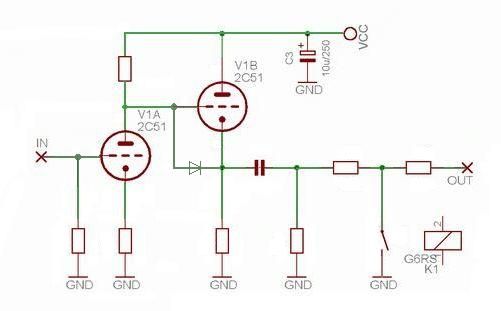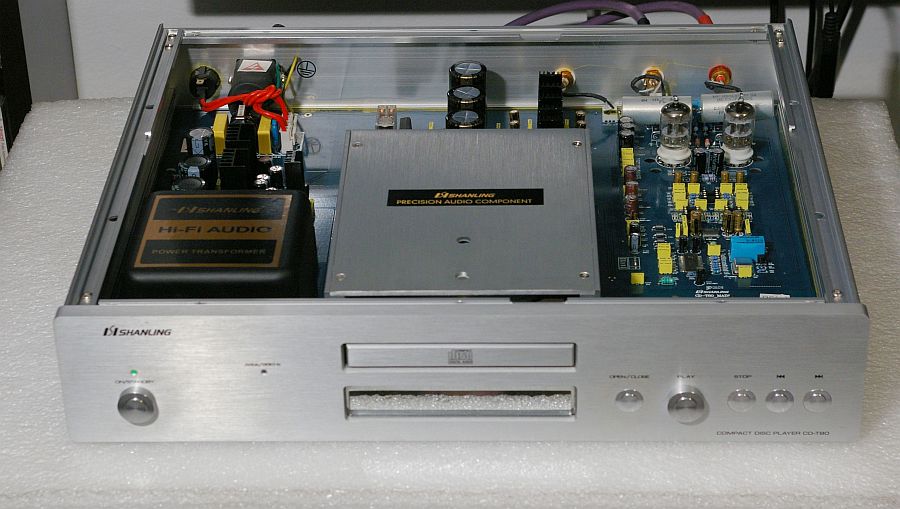Output caps are 2 polarized 220µF/25V nichicon tune gold mounted as one non polarized cap of 110µF, bypassed by an MKP 1µF/400V cap.
Possible upgrades:
2 Black Gate BG N instead of 2 Nichicon.
1 Black Gate BG N instead of 2 Nichicon + 1 MKP
1 MKP 100µF (or perhaps less) instead 2 nichicon+1MKP (not enough space even for smaller ones i fear, like Audyn cap QS)
other (good/bad) idea ?
You can see output caps on this photo
Possible upgrades:
2 Black Gate BG N instead of 2 Nichicon.
1 Black Gate BG N instead of 2 Nichicon + 1 MKP
1 MKP 100µF (or perhaps less) instead 2 nichicon+1MKP (not enough space even for smaller ones i fear, like Audyn cap QS)
other (good/bad) idea ?
You can see output caps on this photo
I don't like BG N's, and for output cap i can not think on anything worse there. (besides a standard lytic) 10 uF MKP (auricap?) would be best, but imo
tubee said:I don't like BG N's, and for output cap i can not think on anything worse there. (besides a standard lytic) 10 uF MKP (auricap?) would be best, but imo
I agree that getting rid of electrolytic cap here would be the best.
10µF seems a bit low, while 111µF (factory value) seems a bit high.
10µF / 200V Auricap cap may fit: 1.27x1.5 inches (3.2cm x 3.8cm)
Greater values will be difficult to fit.
Imho, BG N can be an improvement over nichicon fine gold bypassed by an MKP, but it has to be tested.
digital volume defeatable?
This Shanling T80 looks very promising and I am going to get one.
Just one question: Can the digital volume control be defeated? Or does it have a fixed output?
This Shanling T80 looks very promising and I am going to get one.
Just one question: Can the digital volume control be defeated? Or does it have a fixed output?
It has just variable out, but if the adjusted level is 100% (max), the volume control is skipped by the signal (inside of the PCM1738E) 🙂
Just to keep this Shanling thread going for those that have one, I've finally settled on the LM4562 op-amps, with a pair of Raytheon 5670's.
I initially really loved the OPA2132's, but after living with them for 4-5 months and other changes in my system I started to find them a tad grainy, and a little muddy sounding. Switching back to the LM4562s cured this - they do take a few weeks to really come on song though.
The OPA627s also sound very good also, but the LM4562's are slightly more natural sounding to my ears. The OPA's are awsome with Rock music though.
- John
I initially really loved the OPA2132's, but after living with them for 4-5 months and other changes in my system I started to find them a tad grainy, and a little muddy sounding. Switching back to the LM4562s cured this - they do take a few weeks to really come on song though.
The OPA627s also sound very good also, but the LM4562's are slightly more natural sounding to my ears. The OPA's are awsome with Rock music though.
- John
Hi everyone. I am new to the forum and just started my mod journey not too long ago. I got a set of OPA2132PA and OPA2227PA from a local distributor as free samples. I tested them out and found the 2227 sound better than the 2132. The detail is slightly better and the soundstage seems to be wider. I will keep the 2227 on the CDP for now.
Hi Guys
I have the Shanling CDT-100 and i like it but it seems to lack some detail ?
it's running direclty into Shanling SP-80 mono blocs, i have ordered
2 NOS NIB GE 5 Star Triple Mica Blackplate 5670 which are spposed to be very good and am thinking of changing the op amps to the LM4562 op-amps ?
can someone tell me are these dual op amps and a direct swap for the standard
op amps ? eventually I would like to get more mods done but as i'm disabled now with shakey hands and bad eyesight i will leave it to the pros
thanks for any help
I have the Shanling CDT-100 and i like it but it seems to lack some detail ?
it's running direclty into Shanling SP-80 mono blocs, i have ordered
2 NOS NIB GE 5 Star Triple Mica Blackplate 5670 which are spposed to be very good and am thinking of changing the op amps to the LM4562 op-amps ?
can someone tell me are these dual op amps and a direct swap for the standard
op amps ? eventually I would like to get more mods done but as i'm disabled now with shakey hands and bad eyesight i will leave it to the pros
thanks for any help
Taz: if you are referring to OPA2604 then yes, they are pin compatible with similar specs, only issue with direct swap might be voltage supply, I'm not familiar with CDT-100 but OPA2604 is max +/-24V where's LM4562 is max +/-17V so if you are unsure you can always check it with voltmeter before install
Wow! Talk about a long lived thread!? I just love this inter-webby thing, don't you? ;^)
I have recently acquired a T-80 and am in the process of modding it. I have NOS GE 5670W's already running in it, which made a bigger difference than I was expecting.
I have bought 6 OPA627P's and am waiting for the BrownDog adapters to arrive.
I have a question with respect to the output caps (2 polarized 220µF/25V nichicon tune gold caps, bypassed by MKP 1µF/400V caps). What have people found success with as a replacement?
Also, and I apologize in advance if this is a silly question but, how do you remove the PCB board to get to the caps? It looks like it can slide out the back but so far, I've had no success with this!?
In an email conversation with Troels Gravesenhttp://www.troelsgravesen.dk/ShanlingCD-T80.htm, he told me he just gently rocked the caps off, and applied heat to remove the protruding wires. Is this what others have done?
cheers,
Norm
I have recently acquired a T-80 and am in the process of modding it. I have NOS GE 5670W's already running in it, which made a bigger difference than I was expecting.
I have bought 6 OPA627P's and am waiting for the BrownDog adapters to arrive.
I have a question with respect to the output caps (2 polarized 220µF/25V nichicon tune gold caps, bypassed by MKP 1µF/400V caps). What have people found success with as a replacement?
Also, and I apologize in advance if this is a silly question but, how do you remove the PCB board to get to the caps? It looks like it can slide out the back but so far, I've had no success with this!?
In an email conversation with Troels Gravesenhttp://www.troelsgravesen.dk/ShanlingCD-T80.htm, he told me he just gently rocked the caps off, and applied heat to remove the protruding wires. Is this what others have done?
cheers,
Norm
Last edited:
Frankly, the tube buffer in original form is useless. It is ugly designed and does nothing but affect the sound.

There is my approach to achieve really good sound from this player.
The tube buffer must be redesigned from scratch. Additionally, I decided to completely rid off all the opamp stage.
Now the tube stage looks like this:

It has gain about 16X.
All current outputs of the DAC chip are loaded by 120R conversion resistors. The signal is taken only from negative L and R outputs and tied to tube grids.
The sound is far better than the original.
Now it looks like this:

The output capacitors I installed are vintage german ITT paper in oil, but one can use any of modern high grade signal capacitors. Duelunds CAST-PIO I found best, but they costs much, and I found Audyn True Copper caps has best price/quality ratio. In most cases 0,47uF capacitance is enough, unless you use one of that odd amplifiers that have 5kohm or less input impedance.
And there is a picture of CDT80 working in my whole system:

Ah, I almost forgot. If you want to desolder output capacitors there is no need to remove main PCB from enclosure. You only need to remove a bottom cover.

There is my approach to achieve really good sound from this player.
The tube buffer must be redesigned from scratch. Additionally, I decided to completely rid off all the opamp stage.
Now the tube stage looks like this:

It has gain about 16X.
All current outputs of the DAC chip are loaded by 120R conversion resistors. The signal is taken only from negative L and R outputs and tied to tube grids.
The sound is far better than the original.
Now it looks like this:

The output capacitors I installed are vintage german ITT paper in oil, but one can use any of modern high grade signal capacitors. Duelunds CAST-PIO I found best, but they costs much, and I found Audyn True Copper caps has best price/quality ratio. In most cases 0,47uF capacitance is enough, unless you use one of that odd amplifiers that have 5kohm or less input impedance.
And there is a picture of CDT80 working in my whole system:

Ah, I almost forgot. If you want to desolder output capacitors there is no need to remove main PCB from enclosure. You only need to remove a bottom cover.
Very nice mod indeed, McGyver!
Thanks for the info! I may eventually try what you did, but for now, I'll focus on some simple mods.
Have you ever tried replacing the grid and anode resistors with chokes? I have been reading how some modders are getting very nice results with the Slik Supermalloy grid choke.
cheers,
Norm
Thanks for the info! I may eventually try what you did, but for now, I'll focus on some simple mods.
Have you ever tried replacing the grid and anode resistors with chokes? I have been reading how some modders are getting very nice results with the Slik Supermalloy grid choke.
cheers,
Norm
Hello NordicNorm,
You should not replace grid leak resistor by grid choke in this circuit. Note that grid leak resistor works here as an I/V conversion resistor also, so it must be kept in it's place.
Although there is possibility to use small signal transformer, you can load DAC's Iout by resistor and attach to it the primary winding. The secondary you tie to the grid, and it forms something like grid choke. I tried such solution, but in terms of overall sound quality the resistor alone was significantly better. It is beneficial to use here very good quality resistors, something like Caddock or Shinkoh, depending on wchich sonic signature you prefer.
Also, you are free to try anode choke.
You should not replace grid leak resistor by grid choke in this circuit. Note that grid leak resistor works here as an I/V conversion resistor also, so it must be kept in it's place.
Although there is possibility to use small signal transformer, you can load DAC's Iout by resistor and attach to it the primary winding. The secondary you tie to the grid, and it forms something like grid choke. I tried such solution, but in terms of overall sound quality the resistor alone was significantly better. It is beneficial to use here very good quality resistors, something like Caddock or Shinkoh, depending on wchich sonic signature you prefer.
Also, you are free to try anode choke.
- Status
- Not open for further replies.
- Home
- Source & Line
- Digital Source
- BB OPA2604AP In shanling CD-T80 for OPA627AP?